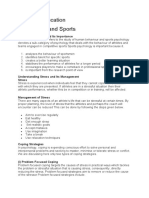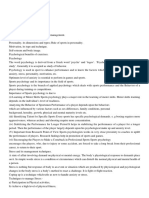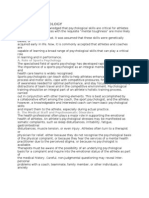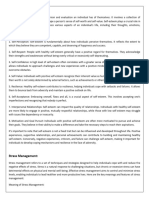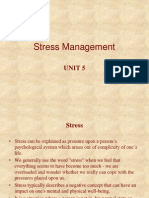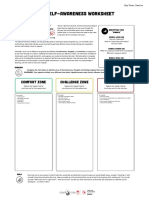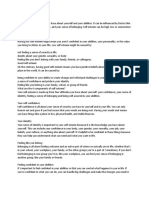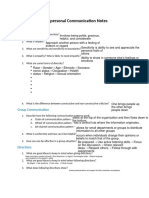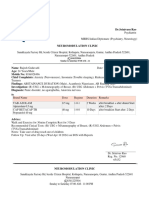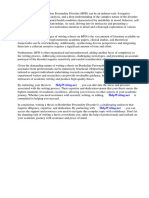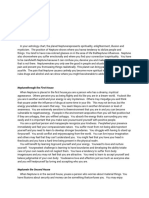Psychology & SPORTS ..12
Uploaded by
parthpal627Psychology & SPORTS ..12
Uploaded by
parthpal627Unit IX Psychology & Sports
1. Personality
Definition
Personality refers to the unique set of psychological traits, patterns of thoughts, feelings, and
behaviors that distinguish one individual from another. It encompasses a range of characteristics
such as temperament, values, attitudes, motives, self-concept, and social skills that influence how
individuals interact with the world around them
It's types
There are various types of personality theories and models.
Jung Classification
Jung classified the personality of an individual into three categories;
1. Introverts; These are the persons who have characteristics such as shyness, social
withdraw and tendency to talk less. These individuals are self-centered, very sensible and
rigid in ideas. They keep their social circle limited.
2. Extroverts; this is the category which is completely opposite to introverts, they are
friendly , social and talkative in nature. They do not have hesitation. They take decision
and act upon it quickly.
3. Ambiverts ; there are only few persons who are pure introverts or pure extroverts , the
remaining persons possess the qualities of both introverts and extroverts.
Big Five Theory
The Big Five theory, also known as the Five Factor Model, is a widely accepted theory of
personality that proposes that there are five core dimensions of personality. These dimensions
include:
● Openness: Refers to an individual's willingness to experience new things, their level of
creativity and imagination, and their appreciation for art and beauty.
● Conscientiousness: Refers to an individual's level of organization, self-discipline, and
responsibility. Conscientious people tend to be reliable and hardworking.
● Extraversion: Refers to an individual's level of sociability, assertiveness, and need for
stimulation. Extraverts tend to be outgoing and energetic.
● Agreeableness: Refers to an individual's level of compassion, cooperativeness, and concern
for others. Agreeable people tend to be kind and empathetic.
● Neuroticism: Refers to an individual's level of emotional instability and tendency to
experience negative emotions such as anxiety, depression, and anger.
These traits are believed to be relatively stable over time and have been found to be consistent
across cultures. The Big Five theory has been widely used in psychology research and has
practical applications in fields such as human resources and personality assessment.
It's important to note that there are many other types of personality theories and models and that
none of these theories can fully capture the complexity of human personality.
MOTIVATION –
Any condition , that might energies and direct our actions is called motivation.
Types of motivation -
;
1. Internsic motivation – it is a type of motivation that comes from the inner soul of an
individual . It occurs when people are compelled to do something out for a pleasure ,
importance or desire.
2. Externsic motivation – Such type of motivation is external , it occurs when external
forces compels a person to do something . ( reward , prize , praise etc.)
TECHNIQUES OF MOTIVATION –
1. Goal setting – It is one of the most important technique of motivation , a person must set
a appropriate and easy to achieve goal , which could be achieved easily and could be
pushed further ( a new goal) , goal must be short term so that the person will not feel
bored
2. Positive attitude – It plays an important role in motivating an individual , because of this
a person lay proper emphasis on “ can be “ mindset.
3. Healthy sports environment – It plays an important role in motivating the sportsperson ,
it consist of good fields , good quality equipment’s , weather , good fields layout etc.
4. Spectators – If there is a huge number of spectators it will have a positive effects in
enhancing the performance of a player , but it also depends on the maturity and
experience of the players.
5. Motivational music
6. Verbal comments
EXERCISE ADHERENCE – REASONS , BENEFITS AND STRATERGIES FOR
ENHANSING IT
Exercise adherence refers to maintaining an exercise regimen for prolonged period of a time
following the initial initial phase.
Reason to exercise –
1. Enhanced physical appearance – exercises not only helps you to feel batter but it also
helps to make your muscles stronger and which in turn make your posture better which
enhances your appearance.
2. Decreased risk of Diseases – by regular exercises the risk of diseases cold be decreased
as exercises improves blood circulation of white blood cells which ultimately make us
immune .
3. For controlling body weight – by regular exercise we are able to manage our body
weight as exercises burns calories , reduces adipose tissues in body .
4. Improves psychological health – Exercise has been proven to provide a mood booster as
it releases the chemical like endorphins into our brain that helps to feel us happier and
reduces depression .
5. Improves social relations – for a good social health social relations are essential , by
joining an exercise group or a class such as dance , hiking club , volleyball team etc our
social relations are improved.
BENEFITS OF EXERCISE –
1. Reduces risk of heart diseases – regular exercises gradually decrease stress
related harmones from circulating in blood stream . it also increases the size
of blood vessels which helps in managing blood pressure.
2. Helps in keeping correct body posture – ( as discussed above)
3. Improve mood – ( as discussed above )
4. Reduced depression – research have shown that exercise helps to boost up
the mood and are beneficial in getting relief from depression .
5. Strength Bones and Muscles
6. Enhances self esteem
7. Reduces stress.
STRATERGIES FOR ENHANSING ADHERENCE TO EXERCISE
1. Simple exercise in the beginning – there is a simple rule for motor development “
simple to complex “ it is beneficial as if we perform simple exercise in the beginning
then these require no equipment and are not complicated which will not disinterest
you and you will be able to continue it.
2. Set appropriate goal – if you will set a goal which is easy to achieve then it will not
only keep you motivated to continue but you will feel happy and easy to gradually
increase your load.
3. Select interesting exercises
4. Be punctual.
5. Don’t overload yourself.
6. Have variability in exercises .
2. Meaning, Concept & Types of Aggressions in
Sports
Meaning & Concept
Aggression in sports refers to behavior that is intended to harm or injure others, both physically
and emotionally. In other words, it is any act that is intended to cause harm to another person,
either intentionally or unintentionally, during a sporting event.
Aggressive behavior can take many forms in sports, ranging from verbal abuse and taunting to
physical violence, such as hitting, pushing, or even intentional fouls. It is important to note that
while aggression is often associated with sports, not all athletes are aggressive, and not all
aggressive behavior is harmful or negative
Types of Aggressions in Sports
There are two types of aggression in sports:
1. Instrumental aggression
2. Hostile aggression.
Instrumental aggression: This type of aggression is considered to be goal-oriented, strategic,
and non-emotional. It is used to achieve a specific goal or outcome in the game, such as winning
a ball, gaining a strategic advantage, or scoring a point. Instrumental aggression is not intended
to harm or injure opponents.
Hostile aggression: Hostile aggression, on the other hand, is characterized by emotional arousal,
anger, and the intention to harm or injure an opponent. This type of aggression is often impulsive
and reactive, and it is not associated with achieving any specific goals or outcomes in the game.
Hostile aggression can be detrimental to both the individual player and the team as a whole, as it
can result in penalties, ejections, and other negative consequences.
3. Psychological Attributes in Sports
Psychological attributes refer to the individual's mental or emotional characteristics that
influence their behavior, thoughts, and feelings. These attributes play a crucial role in sports as
they can have a significant impact on an athlete's performance, ability to handle pressure, and
overall well-being.
Self Esteem
Self-esteem is the way you feel about yourself, your self-worth and your self-respect. In sports, it
is important for athletes to have positive self-esteem as it helps in building confidence,
motivation, and resilience. Athletes with low self-esteem may struggle with self-doubt, negative
thoughts, and anxiety, which can affect their performance. Building self-esteem can be done
through positive reinforcement, setting achievable goals, and focusing on personal growth.
Mental Imagery
Mental imagery, also known as visualization or mental rehearsal, is a technique used by athletes
to imagine themselves performing successfully in their sport. It involves creating vivid and
detailed mental images of yourself successfully completing skills, techniques, and scenarios.
Mental imagery can help athletes improve their performance by increasing confidence, reducing
anxiety, and improving focus and concentration.
Self Talk
Self-talk refers to the internal dialogue that an athlete has with themselves. It can be positive or
negative and can affect an athlete's thoughts, feelings, and behaviours. Positive self-talk involves
using encouraging and supportive language to boost confidence and motivation. Negative self-
talk involves critical and self-deprecating language that can decrease self-esteem and increase
anxiety. Athletes can improve their self-talk by learning to recognize and challenge negative
thoughts and replacing them with positive and supportive ones.
Goal Setting
Goal setting is the process of setting specific, measurable, and achievable objectives for an
athlete to work towards. It is an effective way to motivate athletes, monitor progress, and
improve performance. Goals should be realistic and challenging, and athletes should have a plan
in place to achieve them. The process of setting and achieving goals can help athletes build
confidence, improve focus, and develop resilience.
You might also like
- hsns370 Assessment 2 Submission To Royal Commission Bhima Devi Apodel Adhikari 220179000No ratings yethsns370 Assessment 2 Submission To Royal Commission Bhima Devi Apodel Adhikari 22017900013 pages
- ClASS 12 Unit - 9 PSYCHOLOGY AND SPORTS NotesNo ratings yetClASS 12 Unit - 9 PSYCHOLOGY AND SPORTS Notes9 pages
- Exercise Psychology Krissa Mae G. Dela Torre100% (1)Exercise Psychology Krissa Mae G. Dela Torre23 pages
- Psychology and sports. class 12 unit 09No ratings yetPsychology and sports. class 12 unit 0913 pages
- SELF-MANGEMENT SKILLS GRADE 10 NOTES DdawdNo ratings yetSELF-MANGEMENT SKILLS GRADE 10 NOTES Ddawd4 pages
- Ports Sychology: A. Role of Sports PsychologyNo ratings yetPorts Sychology: A. Role of Sports Psychology10 pages
- Level 4 - Chapter 11 - Mental Training and PsychologyNo ratings yetLevel 4 - Chapter 11 - Mental Training and Psychology33 pages
- 1.0 Behaviour Perception: Strength and ConditioningNo ratings yet1.0 Behaviour Perception: Strength and Conditioning8 pages
- Class 11 Notes Physical Education Chap 9 (2024-25)No ratings yetClass 11 Notes Physical Education Chap 9 (2024-25)3 pages
- [FREE PDF sample] What You Must Think of Me A Firsthand Account of One Teenager s Experience with Social Anxiety Disorder Emily Ford ebooks100% (8)[FREE PDF sample] What You Must Think of Me A Firsthand Account of One Teenager s Experience with Social Anxiety Disorder Emily Ford ebooks50 pages
- Discourse Analysis Adolescent Psychology Final Draft 1No ratings yetDiscourse Analysis Adolescent Psychology Final Draft 16 pages
- Approaches to Art Therapy Theory and Technique Judith Aron Rubin - Get the ebook instantly with just one click100% (1)Approaches to Art Therapy Theory and Technique Judith Aron Rubin - Get the ebook instantly with just one click57 pages
- Age and Self-Esteem As Predictors of Life Satisfaction 4No ratings yetAge and Self-Esteem As Predictors of Life Satisfaction 415 pages
- OB Session 5 Emotions Moods and Stress ManagementNo ratings yetOB Session 5 Emotions Moods and Stress Management50 pages
- Application of Orem Self Care Deficit Theory On Psychiatric PatientNo ratings yetApplication of Orem Self Care Deficit Theory On Psychiatric Patient3 pages
- hsns370 Assessment 2 Submission To Royal Commission Bhima Devi Apodel Adhikari 220179000hsns370 Assessment 2 Submission To Royal Commission Bhima Devi Apodel Adhikari 220179000
- Level 4 - Chapter 11 - Mental Training and PsychologyLevel 4 - Chapter 11 - Mental Training and Psychology
- 1.0 Behaviour Perception: Strength and Conditioning1.0 Behaviour Perception: Strength and Conditioning
- Class 11 Notes Physical Education Chap 9 (2024-25)Class 11 Notes Physical Education Chap 9 (2024-25)
- [FREE PDF sample] What You Must Think of Me A Firsthand Account of One Teenager s Experience with Social Anxiety Disorder Emily Ford ebooks[FREE PDF sample] What You Must Think of Me A Firsthand Account of One Teenager s Experience with Social Anxiety Disorder Emily Ford ebooks
- Discourse Analysis Adolescent Psychology Final Draft 1Discourse Analysis Adolescent Psychology Final Draft 1
- Approaches to Art Therapy Theory and Technique Judith Aron Rubin - Get the ebook instantly with just one clickApproaches to Art Therapy Theory and Technique Judith Aron Rubin - Get the ebook instantly with just one click
- Age and Self-Esteem As Predictors of Life Satisfaction 4Age and Self-Esteem As Predictors of Life Satisfaction 4
- Application of Orem Self Care Deficit Theory On Psychiatric PatientApplication of Orem Self Care Deficit Theory On Psychiatric Patient







